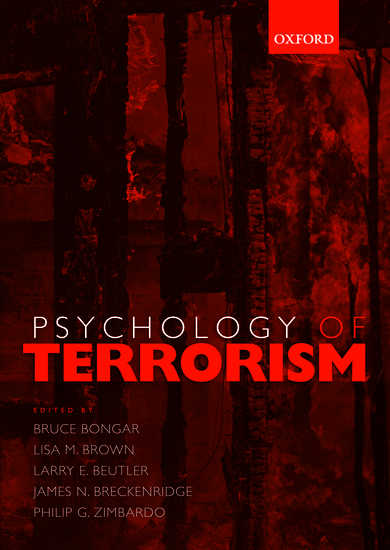By Lisa M. Brown, Ph.D. and Bruce Bongar, Ph.D., ABPP
Immediately after two bombs rocked Boston Marathon bystanders and runners, medical volunteers, Medical Reserve Corp members, and law enforcement were seen running to aid victims. For those who suffered trauma, it is likely that these heroic and timely interventions saved lives and improved outcomes. Regrettably and realistically, most future terrorist targets will not have the benefit of a relatively large cadre of trained first aid responders who are standing by and ready to treat heat stroke and other running-related maladies. By all reports, Boston had taken adequate steps to meet the potential medical needs of the runners and to protect the public from a terrorist attack. Yet even with a pre-event sweep of the area for explosive devises and extra police presence on site, two explosions occurred.

It is well recognized that soft targets, such as races, outdoor concerts, and shopping malls, are much easier to attack than hard targets with a strong security presence, like airports and athletic events held in stadiums. Events or locales that are frequented by the public and not subject to security checks will always be at high risk. Given the likelihood of an increased volume of natural disasters, technological catastrophes, pandemics, and terrorist events it is time to reconsider our existing first aid training model. At present, non-profit agencies like the American Red Cross and the American Heart Association, routinely offer first aid training to first responders as well as to the general public. However, this approach is no longer enough. A key challenge is the small number of people who are trained to provide both medical and psychological intervention. Further compounding this dilemma is the shortage of trained first responders who can be deployed to assist survivors and communities in rural areas or in communities with limited resources. As a nation we would be better served by using an effective training model commonly implemented in public schools by local fire departments.
Across America, many fire departments provide fire safety training to upper grades in elementary schools. Students are taught basic fire safety that includes, but is not limited to verifying the presence of home smoke alarms, having an escape route, and knowing the steps to take should a fire occur. Because of this approach, we have been largely successful in creating a culture that recognizes and values fire preparedness and safety. Incorporating fire safety training into school curriculum makes sense and is easily justified because relative to other types of disasters, fire emergencies are high base-rate events.
Today most buildings are inspected by fire marshals and equipped with a variety of fire alarms, extinguishers, and sprinklers. Additionally, most communities have dedicated personnel, fire stations, and vehicles that are highly visible and ready to respond to emergencies. In marked contrast, it is likely that few people know the location of their local emergency operation center or disaster shelter, have an emergency plan, or own an adequately stocked to-go kit. Given the challenges in preparing for high impact but low base-rate disasters, it is imperative that we expand the model currently in place for fire safety to include first aid training.
A first aid training program should be incorporated into upper middle school curriculum with yearly recertification required. The proposed model should not be solely limited to medical first aid, but should also include training in psychological and mental health first aid. A basic premise of first aid is that appropriate, early intervention can mitigate functional impairment and reduce the potential for more serious and enduring health problems that require formal treatment. A comprehensive first aid program is critical as most natural and human-caused disasters result in a high incidence of psychological and not physical casualties. Just as medical first aid may save lives or offset more serious medical complications, psychological first aid has the potential to mitigate serious mental health consequences and build resilience. Moreover, delivery of psychological first aid in tandem with medical intervention would not only be feasible but highly desirable.
The proposed first aid training approach is appropriate for many types of crises, suitable for training both professional and laypeople, applicable to a broad range of disaster events, and incorporates evidence informed practices. We believe that adoption of the first aid training model described above would represent significant progress in fulfilling a key element of the Pandemic and All-Hazards Preparedness Act of 2006 mandate (PL 109-417). By training all students to use first aid techniques we take an important and much needed step toward preparing our citizenry to respond to all types of disasters.
Lisa Brown and Bruce Bongar are editors of Psychology of Terrorism with Larry E. Beutler, James N. Breckenridge and Philip G. Zimbardo. Lisa M. Brown, Ph.D. is a tenured, Associate Professor in the School of Aging Studies, College of Behavioral and Community Sciences, University of South Florida. Dr. Brown’s clinical and research focus is on aging, health, vulnerable populations, disasters, and long-term care. Since 2004, Dr. Brown has studied the short- and long-term psychosocial reactions and consequences of natural and human-caused disasters. In addition to her scholarly activities, she is also a Medical Reserve Corp volunteer. Bruce Bongar, Ph.D., ABPP, FAPM is the Calvin Professor of Psychology at the Pacific Graduate School of Psychology at Palo Alto University, and Consulting Professor in the Department of Psychiatry and the Behavioral Sciences at Stanford University School of Medicine. Dr. Bongar’s main research focus is on suicidal behavior, clinical emergencies, psychology of terrorism, and suicide terrorism.
Subscribe to the OUPblog via email or RSS.
Subscribe to only health and medicine articles on the OUPblog via email or RSS.




Recent Comments
There are currently no comments.